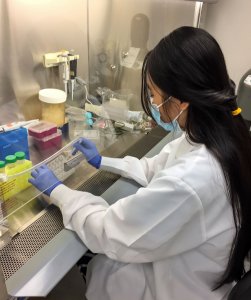SSRP Abstract
Characterization of S1PR2 Specific Radioligand [11c]TZ34-125 in Streptozotocin Induced Diabetic Model

Student: Hien Ngoc Mai ’22
Research Mentors: Zhude Tu and Hao Jiang (Washington University School of Medicine: Mallinckrodt Institute of Radiology)
PET radioligand images is a promising application for diagnosing early-stage disorders and assessing disease progression.
Sphingosine 1-phosphate (S1P) and its receptor S1PR2 play essential roles in many physiological and pathophysiological processes such as diabetes. Studying the role of S1P and its receptor S1PR2 in the process of diabetes would provide novel ideas for the prevention and treatment of diabetes. Radioligand is a promising application for quantifying receptors, and the PET images taken from radioligand can help diagnose early-stage disorders and assess disease progression. Our lab has designed and successfully synthesized the S1PR2 specific radioligand [11c]TZ34-125 compound. We hypothesized that the expression of S1PR2 be increased in streptozotocin (STZ) induced diabetic mice, and the increase of S1PR2 in diabetic mice can be detected by our S1PR2 specific radioligand [11c]TZ34-125. To have induced diabetic models, we injected a single high dose of streptozotocin (STZ) to 10 weeks old mice. We measured the mice’s glucose level and weight level on Day 1, Day 3, and Day 6 after streptozotocin (STZ) injection. Our collected data on the mice’s glucose level and weight level confirmed a successful induced diabetic model. On Day 7, after streptozotocin (STZ) injection, we injected the radioligands [11c]TZ34-125 to the mice, and after 30 minutes, we had biodistribution and tissue collection. We noticed that in the spleen and pancreas of streptozotocin (STZ) treated mice, the uptake level of [11c]TZ34-125 was significantly higher than in the spleen and pancreas of control mice. This data validates our hypothesis that the uptake of radioligand [11c]TZ34-125 is higher in diabetic mice. We performed Immunohistochemistry staining in the pancreases of the streptozotocin (STZ) injected mice and the control mice. The collected data confirmed our hypothesis that S1PR2 had higher expression in diabetic mice, and the increase of S1PR2 in diabetic mice can be detected by our S1PR2 specific radioligand [11c]TZ34-125.
